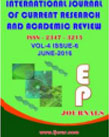Abstract Volume:4 Issue-6 Year-2016 Original Research Articles
 |
Online ISSN : 2347 - 3215 Issues : 12 per year Publisher : Excellent Publishers Email : editorijcret@gmail.com |
Sulfur mustard (SM) or bis (2-chloroethyl) sulfide is a vesicant and alkylating chemical weapon. SM was used in the 1980s against Iran by Iraqi forces. After exposure to SM in initial acute phase the greatest damage is incurred by the eyes, skin and lungs and the highest damage is caused to the lungs.This injury not only in the acute phase but also in the long-term has the highest prevalence among these patients. Clinical symptoms of people after exposure to SM start with irritation of the nose and sinuses in the mild doses to the runny nose and pain at higher doses and even irritation of the airways and bronchial engagement in very high doses. Respiratory complications in patients exposed to SM have been associated with long-term symptoms and these symptoms add to the intensity of the complication. Bloody sputum, feeling of tightness in the chest and shortness of breath over nights are among common symptoms; also the main respiratory symptoms including generalized wheezing, rale (crackle), decreased breath sounds and cyanosis and Apparently FEV1 is reduced by 50 mL/year. In these patients there are changes in blood cells especially in white blood cells and neutrophils and systemic inflammation and systemic changes with other comorbidities are observed. Although SM pulmonary patients’ treatment is based on bronchodilators and long-acting –β2 agonists, paying attention to the comorbidities with prior systemic changes in these patients is a reason for the need to change treatment strategies of these patients with systemic and extra-pulmonary therapy.
How to cite this article:
Hossein Rahmani, Iraj Javadi and Saeed Shirali. 2016. Respiratory Complications Due to Sulfur Mustard ExposureInt.J.Curr.Res.Aca.Rev. 4(6): 143-149doi:



Quick Navigation
- Print Article
- Full Text PDF
- How to Cite this Article
- on Google
- on Google Scholor
- Citation Alert By Google Scholar
